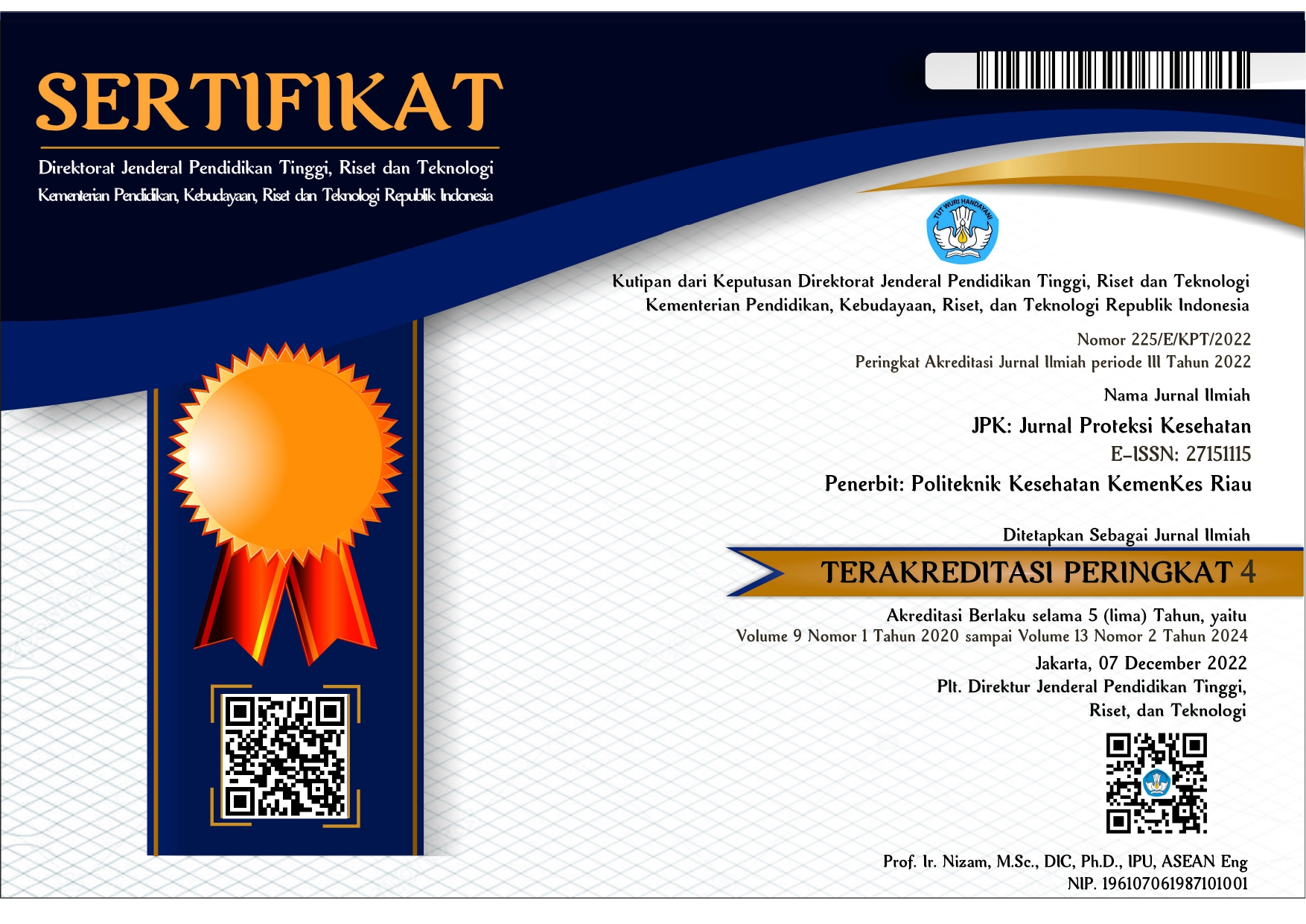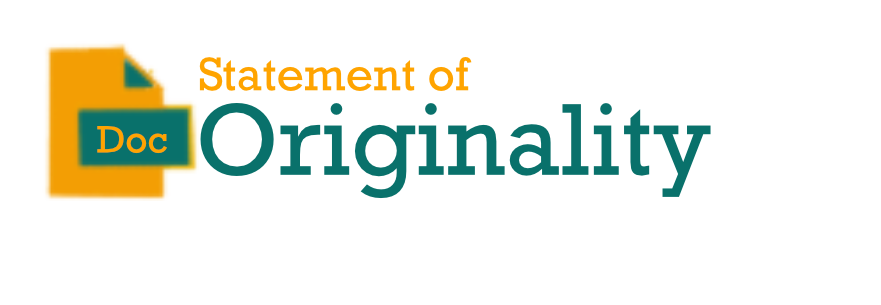Identification of Preservatives And Colourants In Takjil Snacks
Abstract
Healthy food is food that does not contain microbes and chemicals such as dyes and preservatives. Colorants and preservatives are dangerous as food additives such as formaldehyde, borax, rhodamine B, and methanyl yellow. Formalin is an odorless, clear or colorless liquid. Borax is a common harmful cleaner, fungicide, herbicide and pesticide used in everyday life. Rhodamin B and methanil yellow are two examples of illegal food coloring that are commonly used by irresponsible food manufacturers. Methanyl yellow and Rhodamine B are often used as dyes in the textile industry. This study aims to determine the presence of preservatives and coloring agents in takjil food sold in Baru sub-district, Birobuli sub-district, Palu Barat sub-district, and Tondo sub-district, Palu city using a qualitative analysis method with formalin, borax, rhodamin B, and methanil test kits. The results obtained show that all samples sold during the month of Ramadan in the city of Palu do not contain harmful substances and are safe for consumption.
References
[2] T. R. P. Lestari, “Keamanan Pangan Sebagai Salah Satu Upaya Perlindungan Hak Masyarakat Sebagai Konsumen,” Aspirasi: Jurnal Masalah-masalah Sosial, 2020.
[3] Tutik, Eka Fitriani, and Falla Tisyafitri, “Pemanis Dan Pewarna Pada Makanan Jajanan,” Pengabdi. Farm. Malahayati, vol. 5, no. 2, pp. 94–102, 2022, [Online]. Available: https://ejurnalmalahayati.ac.id/index.php/pengabdianfarmasi/article/view/7853
[4] L. Tuslinah, “Analisis Zat Warna Berbahaya Pada Jajanan Anak Sekolah Yang Beredar Di Tasikmalaya,” J. Kesehat. Bakti Tunas Husada J. Ilmu-ilmu Keperawatan, Anal. Kesehat. dan Farm., vol. 17, no. 2, p. 430, 2018, doi: 10.36465/jkbth.v17i2.270.
[5] M. Tahir, N. Nardin, and J. N. S, “Identifikasi pengawet dan pewarna berbahaya pada bumbu giling yang diperjualbelikan di pasar daya Makassar,” J. Media Laboran, vol. 9, no. 1, pp. 21–28, 2019, [Online]. Available: https://uit.e-journal.id/MedLAb/article/view/324
[6] T. Septiani and A. P. Roswien, “Analisis Kualitatif Kandungan Boraks Pada Bahan Pangan Daging Olahan dan Identifikasi Sumber Boron dengan FTIR – ATR,” Indones. J. Halal, vol. 1, no. 1, p. 48, 2018, doi: 10.14710/halal.v1i1.3403.
[7] N. Hadrup, M. Frederiksen, and A. K. Sharma, “Toxicity of boric acid, borax and other boron containing compounds: A review,” Regul. Toxicol. Pharmacol., vol. 121, no. January, p. 104873, 2021, doi: 10.1016/j.yrtph.2021.104873.
[8] H. S. Jeong, H. Chung, S. H. Song, C. Il Kim, J. G. Lee, and Y. S. Kim, “Validation and determination of the contents of acetaldehyde and formaldehyde in foods,” Toxicol. Res., vol. 31, no. 3, pp. 273–278, 2015, doi: 10.5487/TR.2015.31.3.273.
[9] D. Nababan, Ramadhanita Indriana, and R. Sitepu, “Analisis Kandungan Formaldehid Pada Tahu Yang Dijual Di Pasar Kota Medan,” J. Kesehat. Masy. dan Lingkung. Hidup, vol. 1, no. 2, pp. 1–10, 2019.
[10] A. D. Indriani and K. Suwita, “KEAMANAN PANGAN MIE BASAH KUNING (KANDUNGAN BORAKS, FORMALIN, METHANIL YELLOW) DI BEBERAPA PASAR TRADISIONAL KOTA MALANG (Food Safety of Yellow Wet Noodles (Boraks Content, Formalin, Methanyl Yellow) in Several Traditional Market Malang City),” J. Gizi KH, Desember, vol. 2018, no. 1, pp. 42–51, 2018.
[11] R. R. Fauziah, “Kajian Keamanan Pangan Bakso dan Cilok yang Beredar di Lingkungan Universitas Jember Ditinjau dari Kandungan Boraks, Formalin dan TPC,” J. Agroteknologi, vol. 8, no. 1, pp. 67–73, 2014.
[12] S. Sujarwo, R. V. N. Latif, and A. Priharwanti, “Kajian Kandungan Bahan Tambahan Pangan Berbahaya 2018– 2019 Se-Kota Pekalongan Dan Implementasi Perda Kota Pekalongan Nomor 07 Tahun 2013,” J. Litbang Kota Pekalongan, vol. 19, no. 2, pp. 91–103, 2021, doi: 10.54911/litbang.v19i0.123.
[13] N. L. Fitriani and S. Andriyani, “Hubungan Antara Pengetahuan Dengan Sikap Anak Usia Sekolah Akhir (10-12 Tahun) Tentang Makanan Jajanan Di Sd Negeri Ii Tagog Apu Padalarang Kabupaten Bandung Barat Tahun 2015,” J. Pendidik. Keperawatan Indones., vol. 1, no. 1, p. 7, 2015, doi: 10.17509/jpki.v1i1.1184.
[14] D. Utomoa and S. Kholifah, “UJI BORAKS DAN FORMALIN PADA JAJANAN DISEKITAR UNIVERSITAS YUDHARTA PASURUAN,” J. Teknol. Pangan, vol. 9, no. 1, pp. 10–19, 2018.
[15] M. Masthura, “Identifikasi Rhodamin B Dan Methanyl Yellow Pada Manisan Buah Yang Beredar Di Kota Banda Aceh Secara Kualitatif,” Amina, vol. 1, no. 1, pp. 39–44, 2019, doi: 10.22373/amina.v1i1.13.
[16] C. H. Yulianti, “Perbandingan Uji Deteksi Formalin pada Makanan Menggunakan Pereaksi Antilin dan Rapid Tes Kit Formalin ( Labstest ) Comparison of Formalin Detection Test in Foods using Antilin Reagent and Formalin Rapid Test Kit ( Labtest ),” J. Pharm. Sci., vol. 6, no. 1, pp. 53–58, 2021.
[17] Zuri Rismiarti, “PENGARUH VARIASI PELARUT EKSTRAKSI DAN DAYA SIMPAN TERHADAP KADAR ANTOSIANIN DALAM TES KIT UJI FORMALIN BERBAHAN DASAR UBI JALAR UNGU (Ipomoea batatas L. Poir),” J. Atmos., vol. 1, no. 1, pp. 17–23, 2020, doi: 10.36040/atmosphere.v1i1.2779.
[18] A. Nurlailia, L. Sulistyorini, and S. I. Puspikawati, “Analisis Kualitatif Kandungan Boraks pada Makanan di Wilayah Kota Banyuwangi,” Media Gizi Kesmas, vol. 10, no. 2, p. 254, 2021, doi: 10.20473/mgk.v10i2.2021.254-260.
[19] S. N. Muthi’ah and A. Qurrota, “Analisis kandungan boraks pada makanan menggunakan bahan alami kunyit,” Artik. Penelit., no. 2012, pp. 13–18, 2021.
[20] I. Putra, “Identifikasi Formalin Dan Boraks Pada Produk Bakso Di Kecamatan Banyuwangi,” J. Teknol. Pangan Dan Ilmu Pertan., vol. 2, no. 1, pp. 21–31, 2021, doi: 10.36526/jipang.v2i1.1213












